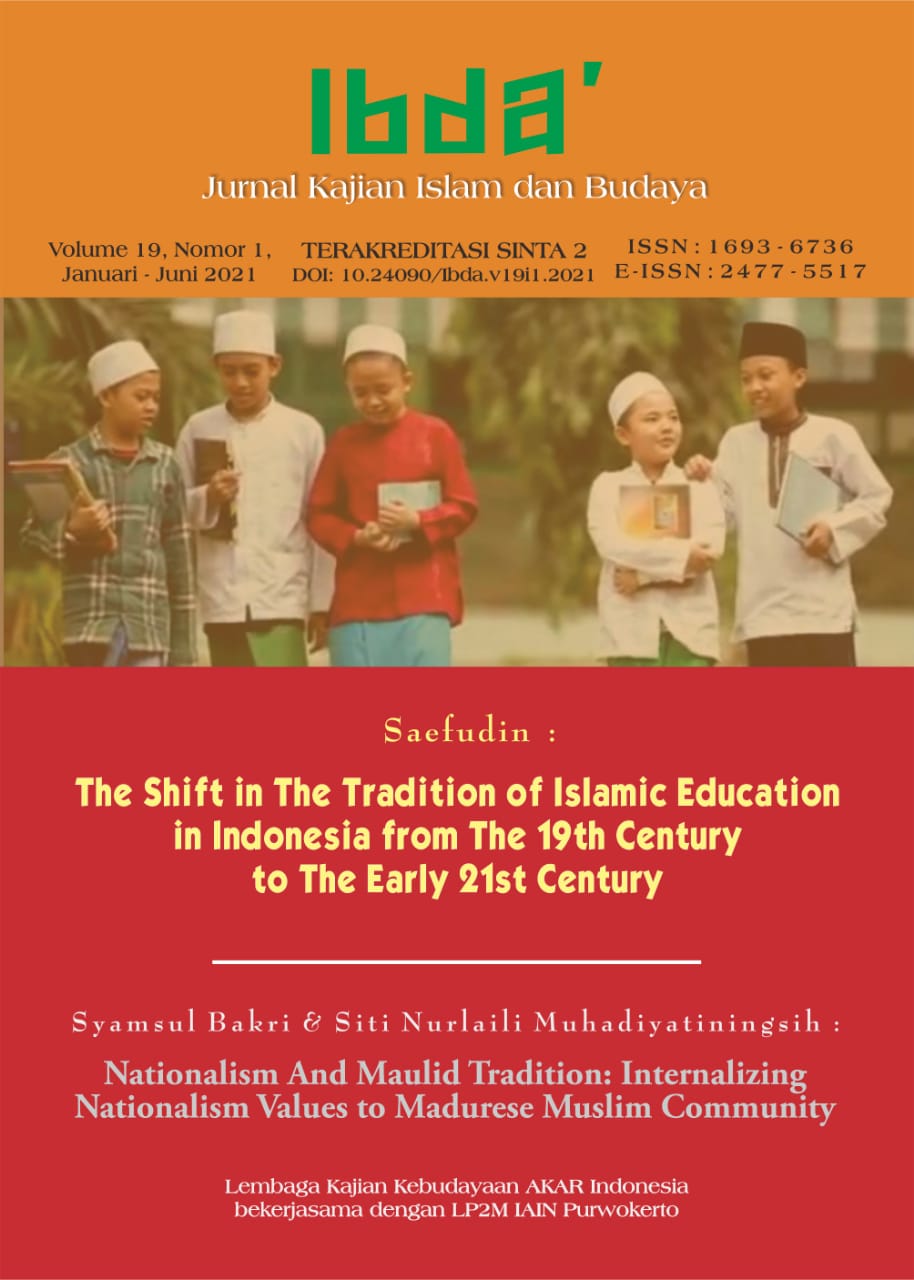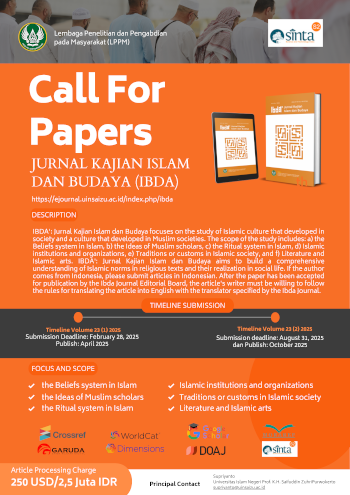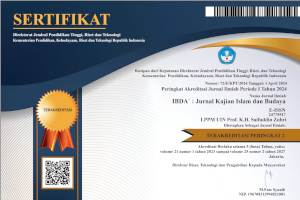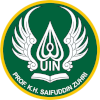Trade and Religious Conversion in the Malay World: Study on Islamization in the Inderapura Kingdom in the 17 th - 18 th Centuries AD
DOI:
https://doi.org/10.24090/ibda.v19i1.3728Keywords:
Trade, Religious Conversion, MalayAbstract
This study was derived from a paradegm developed by historians that the process of conversion to Islam in the Malay world was spread dominantly by the Sufis. As a result, historical reconstruction in this region has always been linked to the teachings, rituals and religious behavior of the Sufi. Based on available sources (manuscripts and archives), the role of traders was very significant in conversion to Islam in the Malay world. Through trade and religion, the countries in the Indian Ocean were interconnected. The religious conversion among traders grew faster as in the 17-18th century AD traders from various regions came to the West Coast of Sumatra to get spices. Most of these traders have embraced Islam. The Muslim traders carried the spirit of the Koran in their right hands and the commodities in the left hand. This spirit of spreading Islam was the driving force of the merchants to spread Islam in every place they visited. This research has implications for the community’s perspective on Islam in the Malay world because Islam that was brought by traders was progressive and flexible about the local culture. This study is a historical socio-religious study that is examined through three ap- proaches, namely historical approach, social approach, and religious approach. This study found that the religious conversion in the Malay world was succeeded mostly by the merchants. To facilitate the conversion, they married local women and negotiated with the authorized Sultan.Downloads
Download data is not yet available.
References
A.H. Johns. (1961). Muslim Mystic and Historical Writing. In D. Hall (Ed.), Historians of South East Asia. London: Oxford University Press.
Abdurrahman, D. (2011). Metodologi Penelitian Sejarah Islam. Yogyakarta: Penerbit Ombak.
Alfian, I. (1992). Tentang Metodologi Sejarah†dalam T. Ibrahim Alfian, dkk (eds), Dari Babad dan Hikayat sampai Sejarah Kritis. Yogyakarta: Gadjah Mada Uinversity Press.
Amran, R. (1981). Sumatra Barat hingga Plakat Panjang. Jakarta: Sinar Harapan.
Arnold, T. . (1913). The Preaching of Islam: History of the Propagation of the Muslim Faith. London: Constable.
Asnan, G. (2012). Dinamika Sistem Birokrasi pada Masa Kesultanan Inderapura Abad XVI-Awal Abad XX M. Jakarta: Penelitian Puslitbang Lektur dan Khazanah Keagamaan Kementerian Agama RI.
Azra, A. (2002). Jaringan Global dan Lokal Islam Nusantara. Bandung: Mizan.
Azra, A. (2004). Jaringan Ulama Timur Tengah dan Kepulauan Nusantara
Abad XVII & XVIII Akar Pembaharuan Islam Indonesia. Jakarta: Kencana Prenada Media Group.
de Graaf, H. J. (1970). South Asian Islam†to the eighteenth Century. In et al
P.M. Holf (Ed.), Cambridge History of Islam. London: the Cambridge University Press.
Dobbin, C. (n.d.). Gejolah Ekonomi, Kebangkitan Islam.
Fatimi, S. (1961). Islam Comes to Malaysia . Singapore: Malaysian Sociological Institute.
Hadi, A. (2004). Islam and State in Sumatra: A Study of Seventeenth-Centure Aceh. Leiden: Brill.
Hamka. (1981). Sejarah Ummat Islam. Jakarta: Bulan Bintang.
Hasbullah, M. (n.d.). Perdagangan, Internasionalisme dan Konversi Agama; perspektif Psiko-sosial dalam Islamisasi di Nusantara Abad ke 15-17. Mimbar: Jurnal Kajian Dan Budaya, Lembaga Penelitian (LEMLIT) UIN Syarif Hidayatullah, 29, 17–18.
Huda, N. (2012). Islamisme dan Komunismeâ€: Melacak Genealogi Intelektual Hadji Mohammad Misbach (1876-1926). UIN Sunan Kalijaga.
Lohanda, M. (2011). Membaca Sumber Menulis Sejarah. Yogyakarta: Ombak.
Milner, A. C. (1983). Islam and the Muslim State. In M. . Hooker (Ed.), Islam in South-East Asia. Leiden.
Muller, S. (1838). Reizen en Onderzoekingen in Sumatra.
Neher, C. D. (1981). Politics in Southeast Asia. Inc. Cambrige, Massachusetts: Schenkman Publishing Company.
Pires, T. (n.d.). Suma Oriental/ ; Perjalanan dari Laut Merah.
Pusponegoro, Marwati Djoned, Notosusanto, N. (1990). Sejarah Nasional Indonesia. Jakarta: Balai Pustaka.
Schrieke. (1955). Indonesian Sociological Studies. Den Haag: Van Hoeve.
Sjamsuddin, H. (n.d.). Metodologi Sejarah.
St Indera, D. C. (1970). Sedjarah Keradjaan Inderapura. Padang: Panitia Seminar Sedjarah dan Kebudayaan Minangkabau.
Van Leur, J. C. (1983). Indonesia Trade and Sociaty: Assays in Asian Social and Economic History. Holland: Dordrecht.
Yunus, Y. (2002). Kesultanan Indrapura dan Mandeh Rubiyah di Lunang: Spirit Sejarah dan Kerajaan Bahari hingga Semangat Melayu Dunia. Padang: IAIN-IB Press.
Zainuddin. (1961). Tarich Atjeh. Medan: Pustaka Iskandar Muda.
Abdurrahman, D. (2011). Metodologi Penelitian Sejarah Islam. Yogyakarta: Penerbit Ombak.
Alfian, I. (1992). Tentang Metodologi Sejarah†dalam T. Ibrahim Alfian, dkk (eds), Dari Babad dan Hikayat sampai Sejarah Kritis. Yogyakarta: Gadjah Mada Uinversity Press.
Amran, R. (1981). Sumatra Barat hingga Plakat Panjang. Jakarta: Sinar Harapan.
Arnold, T. . (1913). The Preaching of Islam: History of the Propagation of the Muslim Faith. London: Constable.
Asnan, G. (2012). Dinamika Sistem Birokrasi pada Masa Kesultanan Inderapura Abad XVI-Awal Abad XX M. Jakarta: Penelitian Puslitbang Lektur dan Khazanah Keagamaan Kementerian Agama RI.
Azra, A. (2002). Jaringan Global dan Lokal Islam Nusantara. Bandung: Mizan.
Azra, A. (2004). Jaringan Ulama Timur Tengah dan Kepulauan Nusantara
Abad XVII & XVIII Akar Pembaharuan Islam Indonesia. Jakarta: Kencana Prenada Media Group.
de Graaf, H. J. (1970). South Asian Islam†to the eighteenth Century. In et al
P.M. Holf (Ed.), Cambridge History of Islam. London: the Cambridge University Press.
Dobbin, C. (n.d.). Gejolah Ekonomi, Kebangkitan Islam.
Fatimi, S. (1961). Islam Comes to Malaysia . Singapore: Malaysian Sociological Institute.
Hadi, A. (2004). Islam and State in Sumatra: A Study of Seventeenth-Centure Aceh. Leiden: Brill.
Hamka. (1981). Sejarah Ummat Islam. Jakarta: Bulan Bintang.
Hasbullah, M. (n.d.). Perdagangan, Internasionalisme dan Konversi Agama; perspektif Psiko-sosial dalam Islamisasi di Nusantara Abad ke 15-17. Mimbar: Jurnal Kajian Dan Budaya, Lembaga Penelitian (LEMLIT) UIN Syarif Hidayatullah, 29, 17–18.
Huda, N. (2012). Islamisme dan Komunismeâ€: Melacak Genealogi Intelektual Hadji Mohammad Misbach (1876-1926). UIN Sunan Kalijaga.
Lohanda, M. (2011). Membaca Sumber Menulis Sejarah. Yogyakarta: Ombak.
Milner, A. C. (1983). Islam and the Muslim State. In M. . Hooker (Ed.), Islam in South-East Asia. Leiden.
Muller, S. (1838). Reizen en Onderzoekingen in Sumatra.
Neher, C. D. (1981). Politics in Southeast Asia. Inc. Cambrige, Massachusetts: Schenkman Publishing Company.
Pires, T. (n.d.). Suma Oriental/ ; Perjalanan dari Laut Merah.
Pusponegoro, Marwati Djoned, Notosusanto, N. (1990). Sejarah Nasional Indonesia. Jakarta: Balai Pustaka.
Schrieke. (1955). Indonesian Sociological Studies. Den Haag: Van Hoeve.
Sjamsuddin, H. (n.d.). Metodologi Sejarah.
St Indera, D. C. (1970). Sedjarah Keradjaan Inderapura. Padang: Panitia Seminar Sedjarah dan Kebudayaan Minangkabau.
Van Leur, J. C. (1983). Indonesia Trade and Sociaty: Assays in Asian Social and Economic History. Holland: Dordrecht.
Yunus, Y. (2002). Kesultanan Indrapura dan Mandeh Rubiyah di Lunang: Spirit Sejarah dan Kerajaan Bahari hingga Semangat Melayu Dunia. Padang: IAIN-IB Press.
Zainuddin. (1961). Tarich Atjeh. Medan: Pustaka Iskandar Muda.
Downloads
Published
2021-01-24
How to Cite
Sudarman, S., Rahmi, A., Wusqo, U., Halimy, S., & Rahmawati, R. (2021). Trade and Religious Conversion in the Malay World: Study on Islamization in the Inderapura Kingdom in the 17 th - 18 th Centuries AD. IBDA` : Jurnal Kajian Islam Dan Budaya, 19(1), 44–57. https://doi.org/10.24090/ibda.v19i1.3728
Issue
Section
Articles
License
Authors who publish with this journal agree to the following terms:
- Authors retain copyright and grant the journal right of first publication with the work simultaneously licensed under a Creative Commons Attribution-ShareAlike License a that allows others to share the work with an acknowledgement of the work's authorship and initial publication in this journal.
- Authors are able to enter into separate, additional contractual arrangements for the non-exclusive distribution of the journal's published version of the work (e.g., post it to an institutional repository or publish it in a book), with an acknowledgment of its initial publication in this journal.
- Authors are permitted and encouraged to post their work online (e.g., in institutional repositories or on their website) before and during the submission process, as it can lead to productive exchanges, as well as earlier and greater citation of published work (See The Effect of Open Access).
















